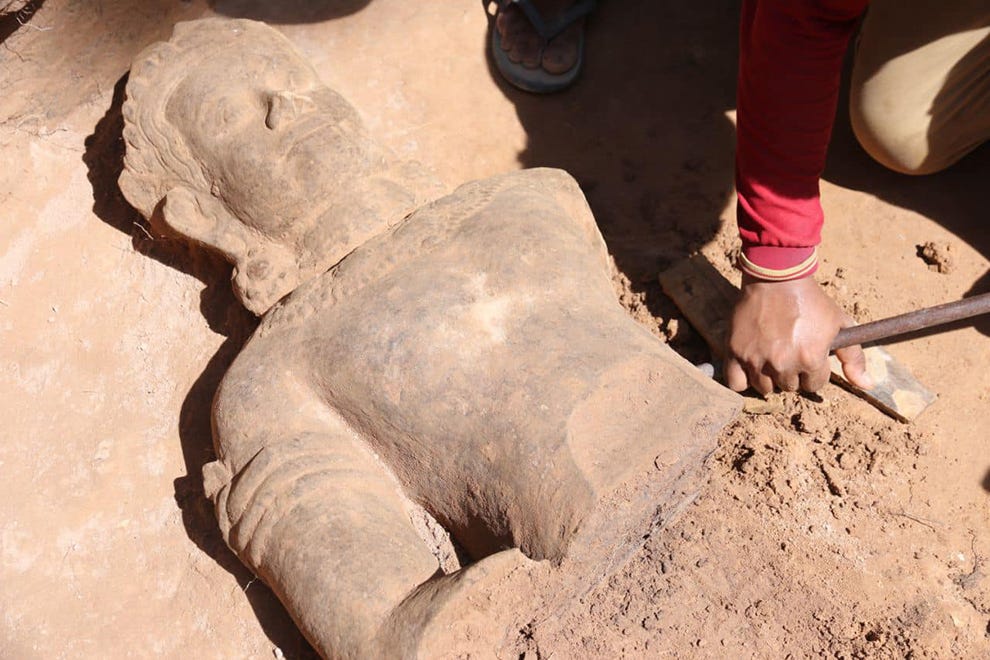🧐 Ancient Beat #123: Egyptian astronomers, the Dolmen of Menga, and the effect of fear on population growth
Hi folks! Welcome to issue #123 of Ancient Beat. Let’s get right into it. Here’s the latest ancient news. 👇
🗞 Ancient News: Top 5
2,500-Year-Old Astronomical Observatory Discovered in Egypt — A 2,500-year-old astronomical observatory has been uncovered in Egypt’s Western Desert. The site, dating to the Late Period, consists of a circular arrangement of stones that align with the rising and setting of the sun during solstices and equinoxes. Nearby, archaeologists found offerings, including pottery and animal bones, suggesting the observatory was also a ritual site.
Builders of Massive Ancient Monument Understood the Science Behind Their Work — According to a new study, the Dolmen of Menga, a 6,000-year-old megalithic structure in southern Spain, demonstrates advanced engineering knowledge of its Neolithic builders. That will surprise exactly zero people who have seen this dolmen, but the specifics are interesting. Constructed between 3800 BCE and 3600 BCE, this massive monument comprises 32 limestone blocks weighing a total of 1,140 tons, with the largest stone weighing 150 tons. The builders used sophisticated techniques, embedding stones deep into bedrock for stability and using a slight convex shape in the ceiling stone to distribute weight, making Menga the earliest known use of the arch principle. The stones were likely transported downhill from a quarry 850 meters away, possibly using sledges. This monumental achievement suggests that the builders possessed a profound understanding of geometry, physics, and geology, challenging the notion that prehistoric societies lacked scientific knowledge. Despite the absence of written records, Menga’s construction serves as a testament to the ingenuity and scientific mindset of its creators.
Newly Discovered Sandstone Guardian Unearthed At Banteay Prei Temple — Archaeologists in Cambodia have unearthed a sandstone guardian statue at the Banteay Prei temple in the Angkor Archaeological Park. The statue, dating back to the late 12th century CE during the reign of King Jayavarman VII, was found in a well-preserved state despite centuries of exposure. The guardian, likely a dvarapala (meaning “door guard” — usually warriors or giants), was placed to protect the temple’s sanctity. This discovery is significant as it sheds light on the religious and cultural practices of the Khmer Empire.
What Role Did Fear Play In Europe's Population Growth? — Fear of conflict may have significantly influenced the development of prehistoric European societies, according to a study focused on Neolithic Europe (circa 7000 BCE to 3000 BCE). Researchers used a computational model to simulate population dynamics, suggesting that fear, rather than direct conflict, led to significant population fluctuations. This fear drove people to abandon open agricultural lands and concentrate in well-defended hilltop sites, such as Kapellenberg in Germany around 3700 BCE. This concentration in fortified locations likely resulted in overpopulation, higher mortality, and lower fertility rates. The model’s findings align with archaeological evidence, highlighting that fear-induced migrations and the construction of large-scale defense systems played a key role in shaping early European societies. This research underscores how fear, alongside conflict, may have contributed to the emergence of wealth disparities and political structures that paved the way for early states.
10,000-Year-Old Hunting Stop — And Animal Burial Pits — Uncovered In France — Archaeologists have discovered a site in Mézières, in the Indre region of central France, revealing evidence of human occupation spanning at least 10,000 years. The oldest artifacts are microliths, small stone tools likely used as arrowheads by Mesolithic hunter-gatherers around 8000 BCE. This site was probably a temporary hunting camp, as indicated by the 160-square-foot area containing the tools. Subsequent layers of the site reveal a range of artifacts, including 14 raw flint blades from the Late Neolithic period (3400-2900 BCE) used for daggers and traded over long distances. The site’s purpose evolved during the Bronze Age (2200-800 BCE), with discoveries of ceramic dishes and decorated containers. During the Iron Age (800-450 BCE), the site became a funerary area, with graves containing human and animal remains, including horses and dogs. In the Middle Ages, the area was settled again, with huts, a well, and an oven uncovered, along with early medieval artifacts like a bronze ring and decorated clasp. This rich site provides a unique window into the continuous human activity in western Europe over millennia.
That’s it for the free Top 5! If you’re a free subscriber, sign up for the paid plan for another 23 discoveries and 7 recommended pieces of content covering Viking violence, Thracians, battering rams, swords, gardens, and genetics.
Until next time, thanks for joining me!
-James
Twitter: @jamesofthedrum
P.S. If you want access but it’s a little too steep for you right now, just email me — I want this to be accessible.
P.P.S. Paid members, read on!




